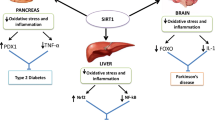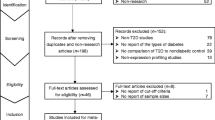ABSTRACT
Purpose
Peroxisome proliferator-activated receptor α (PPARα) is an important transcriptional factor that regulates genes encoding endo/xenobiotic enzymes and lipid metabolizing enzymes. In this study, we investigated whether microRNAs (miRNAs) are involved in the regulation of PPARα in human liver.
Methods
Precursor or antisense oligonucleotide for miR-21 or miR-27b was transfected into HuH7 cells; expression of PPARα and acyl-CoA synthetase M2B was determined by Western blot and real-time RT-PCR. Luciferase assay was performed to identify the functional miRNA recognition element (MRE). Expression levels of PPARα, miR-21, and miR-27b in a panel of 24 human livers were determined.
Results
The overexpression and inhibition of miR-21 or miR-27b in HuH7 cells significantly decreased and increased the PPARα protein level, respectively, but not PPARα mRNA level. The miRNA-dependent regulation of PPARα affected the expression of its downstream gene. Luciferase assay identified a functional MRE for miR-21 in the 3′-untranslated region of PPARα. In human livers, the PPARα protein levels were not correlated with PPARα mRNA, but inversely correlated with the miR-21 levels, suggesting a substantial impact of miR-21, although the contribution of miR-27b could not be ruled out.
Conclusions
We found that PPARα in human liver is regulated by miRNAs.



Similar content being viewed by others
Abbreviations
- ACS:
-
acyl-CoA synthetase
- AsO:
-
antisense LNA/DNA oligonucleotide
- DMEM:
-
Dulbecco’s modified Eagle’s medium
- FBS:
-
fetal bovine serum
- IL-6:
-
interleukin-6
- LNA:
-
locked nucleic acid
- miRNA:
-
microRNA
- MRE:
-
miRNA recognition element
- PPAR:
-
peroxisome proliferator-activated receptor
- RXR:
-
retinoid X receptor
- Stat3:
-
signal transducer and activator of transcription 3
REFERENCES
Shah YM, Morimura K, Yang Q, Tanabe T, Takagi M, Gonzalez FJ. Peroxisome proliferator-activated receptor α regulates a microRNA-mediated signaling cascade responsible for hepatocellular proliferation. Mol Cell Biol. 2007;27(12):4238–47.
Kersten S, Desvergne B, Wahli W. Roles of PPARs in health and disease. Nature. 2000;405(6785):421–4.
van Raalte DH, Li M, Pritchard PH, Wasan KM. Peroxisome proliferator-activated receptor (PPAR)-α: a pharmacological target with a promising future. Pharm Res. 2004;21(9):1531–8.
Martin G, Schoonjans K, Lefebvre AM, Staels B, Auwerx J. Coordinate regulation of the expression of the fatty acid transport protein and acyl-CoA synthetase genes by PPARα and PPARγ activators. J Biol Chem. 1997;272(45):28210–7.
Raucy JL, Lasker J, Ozaki K, Zoleta V. Regulation of CYP2E1 by ethanol and palmitic acid and CYP4A11 by clofibrate in primary cultures of human hepatocytes. Toxicol Sci. 2004;79(2):233–41.
Barbier O, Villeneuve L, Bocher V, Fontaine C, Pineda-Torra I, Duhem C, et al. The UDP-glucuronosyltransferase 1A9 enzyme is a peroxisome proliferator-activated receptor α and γ target gene. J Biol Chem. 2003;278(16):13975–83.
Barbier O, Duran-Sandoval D, Pineda-Torra I, Kosykh V, Fruchart JC, Staels B. Peroxisome proliferator-activated receptor α induces hepatic expression of the human bile acid glucuronidating UDP-glucuronosyltransferase 2B4 enzyme. J Biol Chem. 2003;278(35):32852–60.
Bartel DP. MicroRNAs: genomics, biogenesis, mechanism, and function. Cell. 2004;116(2):281–97.
Ambros V. The functions of animal microRNAs. Nature. 2004;431(7006):350–5.
Calin GA, Sevignani C, Dumitru CD, Hyslop T, Noch E, Yendamuri S, et al. Human microRNA genes are frequently located at fragile sites and genomic regions involved in cancers. Proc Natl Acad Sci USA. 2004;101(9):2999–3004.
Lu J, Getz G, Miska EA, Alvarez-Saavedra E, Lamb J, Peck D, et al. MicroRNA expression profiles classify human cancers. Nature. 2005;435(7043):834–8.
Friedman RC, Farh KK, Burge CB, Bartel DP. Most mammalian miRNAs are conserved targets of microRNAs. Genome Res. 2009;19(1):92–105.
Takagi S, Nakajima M, Mohri T, Yokoi T. Post-transcriptional regulation of human pregnane X receptor by microRNA affects the expression of cytochrome P450 3A4. J Biol Chem. 2008;283(15):9674–80.
Mohri T, Nakajima M, Takagi S, Komagata S, Yokoi T. MicroRNA regulates human vitamin D receptor. Int J Cancer. 2009;125(6):1328–33.
Takagi S, Nakajima M, Kida K, Yamaura Y, Fukami T, Yokoi T. MicroRNAs regulate human hepatocyte nuclear factor 4α, modulating the expression of metabolic enzymes and cell cycle. J Biol Chem. 2010;285(7):4415–22.
Jennewein C, Knethen AV, Schmid T, Brune B. MicroRNA-27b contributes to lipopolysaccharide-mediated peroxisome proliferator-activated receptor γ (PPARγ) mRNA destabilization. J Biol Chem. 2010;285(16):11846–53.
Vreugdenhil E, Verissimo CS, Mariman R, Kamporst JT, Barbosa JS, Zweers T, et al. MicroRNA 18 and 124a down-regulate the glucocorticoid receptor: implications for glucocorticoid responsiveness in the brain. Endocrinology. 2009;150(5):2220–8.
Al-Nakhle H, Burns PA, Cummings M, Hanby AM, Hughes TA, Satheesha S, et al. Estrogen receptor β1 expression is regulated by miR-92 in breast cancer. Cancer Res. 2010;70(11):4778–84.
Tsuchiya Y, Nakajima M, Kyo S, Kanaya T, Inoue M, Yokoi T. Human CYP1B1 is regulated by estradiol via estrogen receptor. Cancer Res. 2004;64(9):3119–25.
Yaacob NS, Norazmi MN, Gibson GG, Kass GE. The transcription of the Peroxisome proliferator-activated receptor α is regulated by protein kinase C. Toxicol Lett. 2001;125(1–3):133–41.
Barger PM, Browning AC, Garner AN, Kelly DP. p38 mitogen-activated protein kinase activates peroxisome proliferator-activated receptor α. J Biol Chem. 2001;276(48):44495–501.
Lemberger T, Saladin R, Vazquez M, Assimacopoulos F, Staels B, Desvergne B, et al. Expression of the peroxisome proliferator-activated receptor α gene is stimulated by stress and follows a diurnal rhythm. J Biol Chem. 1996;271(3):1764–9.
Blanquart C, Mansouri R, Paumelle R, Fruchart JC, Staels B, Glineur C. The protein kinase C signaling pathway regulates a molecular switch between transactivation and transrepression activity of the peroxisome proliferator-activated receptor α. Mol Endocrinol. 2004;18(8):1906–18.
Juge-Aubry CE, Hammar E, Siegrist-Kaiser C, Pernin A, Takeshita A, Chin WW, et al. Regulation of the transcriptional activity of the peroxisome proliferator-activated receptor α by phosphorylation of a ligand-independent trans-activating domein. J Biol Chem. 1999;274(15):10505–10.
Iliopoulos D, Malizos KN, Oikonomou P, Tsezou A. Integrative microRNA and proteomic approaches identify novel osteoarthritis genes and their collaborative metabolic and inflammatory networks. PLoS ONE. 2008;3(11):e3740.
Zheng L, Lv GC, Sheng J, Yang YD. Effect of miRNA-10b in regulating cellular steatosis level by targeting PPAR-α expression, a novel mechanism for the pathogenesis of NAFLD. J Gastroenterol Hepatol. 2010;25(1):156–63.
Barad O, Meiri E, Avniel A, Aharonov R, Barzilai A, Bentwich I, et al. MicroRNA expression detected by oligonucleotide microarrays: system establishment and expression profiling in human tissues. Genome Res. 2004;14(12):2486–94.
Loffler D, Brocke-Heidrich K, Pfeifer G, Stocsits C, Hackermuller J, Kretzschmar AK, et al. Interleukin-6-dependent survival of multiple myeloma cells involves the Stat3-mediated induction of microRNA-21 through a highly conserved enhancer. Blood. 2007;110(4):1330–3.
Wegenka UM, Buschmann J, Lutticken C, Heinrich PC, Horn F. Acute-phase response factor, a nuclear factor binding to acute-phase response elements, is rapidly activated by interleukin-6 at the posttranslational level. Mol Cell Biol. 1993;13(1):276–88.
Gervois P, Vu-Dac N, Kleemann R, Kockx M, Dubois G, Laine B, et al. Negative regulation of human fibrinogen gene expression by peroxisome proliferator-activated receptor α agonists via inhibition of CCAAT box/enhancer-binding protein β. J Biol Chem. 2001;276(36):33471–7.
Lin Q, Gao Z, Alarcon RM, Ye J, Yun Z. A role of miR-27 in the regulation of adipogenesis. FEBS J. 2009;276(8):2348–58.
Ji J, Zhang J, Huang G, Qian J, Wang X, Mei S. Over-expressed microRNA-27a and 27b influence fat accumulation and cell proliferation during rat hepatic stellate cell activation. FEBS Lett. 2009;583(4):759–66.
ACKNOWLEDGMENTS
This work was supported in part by Grant-in-Aid for Scientific Research (B) from Japan Society for the Promotion of Science. We acknowledge Mr. Brent Bell for reviewing the manuscript.
Author information
Authors and Affiliations
Corresponding author
Rights and permissions
About this article
Cite this article
Kida, K., Nakajima, M., Mohri, T. et al. PPARα Is Regulated by miR-21 and miR-27b in Human Liver. Pharm Res 28, 2467–2476 (2011). https://doi.org/10.1007/s11095-011-0473-y
Received:
Accepted:
Published:
Issue Date:
DOI: https://doi.org/10.1007/s11095-011-0473-y




